Business Law: English Legal System, Responsibilities and Solutions
VerifiedAdded on 2020/10/04
|17
|5883
|78
Report
AI Summary
This report provides a detailed overview of the English legal system, including its structure and various sources of law that organizations must comply with, such as EU law, jurisprudence, common law, and statutory laws. It explains the role of the government in law-making and the legal responsibilities of employers, emphasizing occupational health and safety, fair treatment, and contract law. The report also suggests appropriate legal solutions for business problems, assesses the impact of these solutions, and explores the benefits of alternative dispute resolution (ADR), comparing and contrasting the effectiveness of different recommendations. The conclusion summarizes the key findings and insights presented throughout the report, and references are provided to support the information.
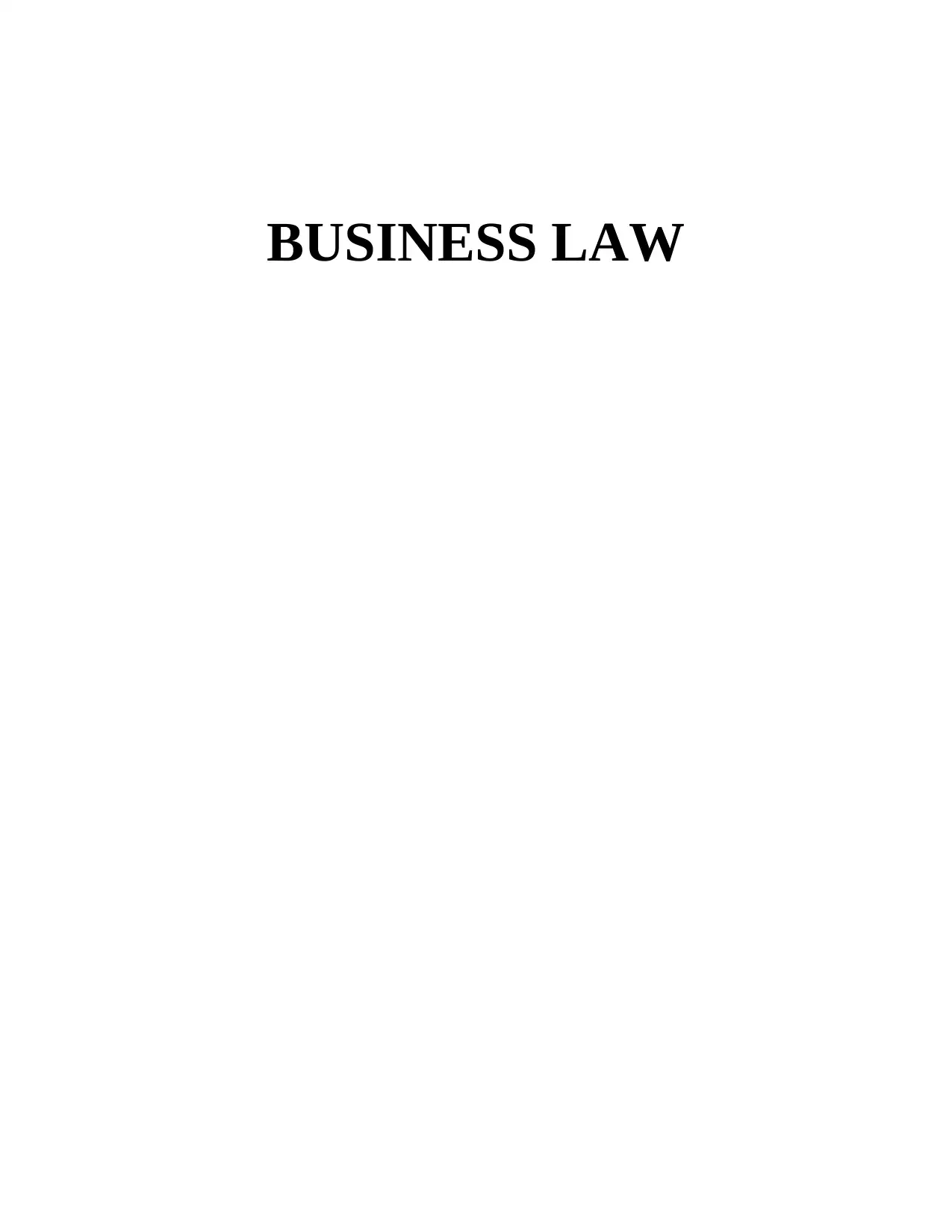
BUSINESS LAW
Secure Best Marks with AI Grader
Need help grading? Try our AI Grader for instant feedback on your assignments.
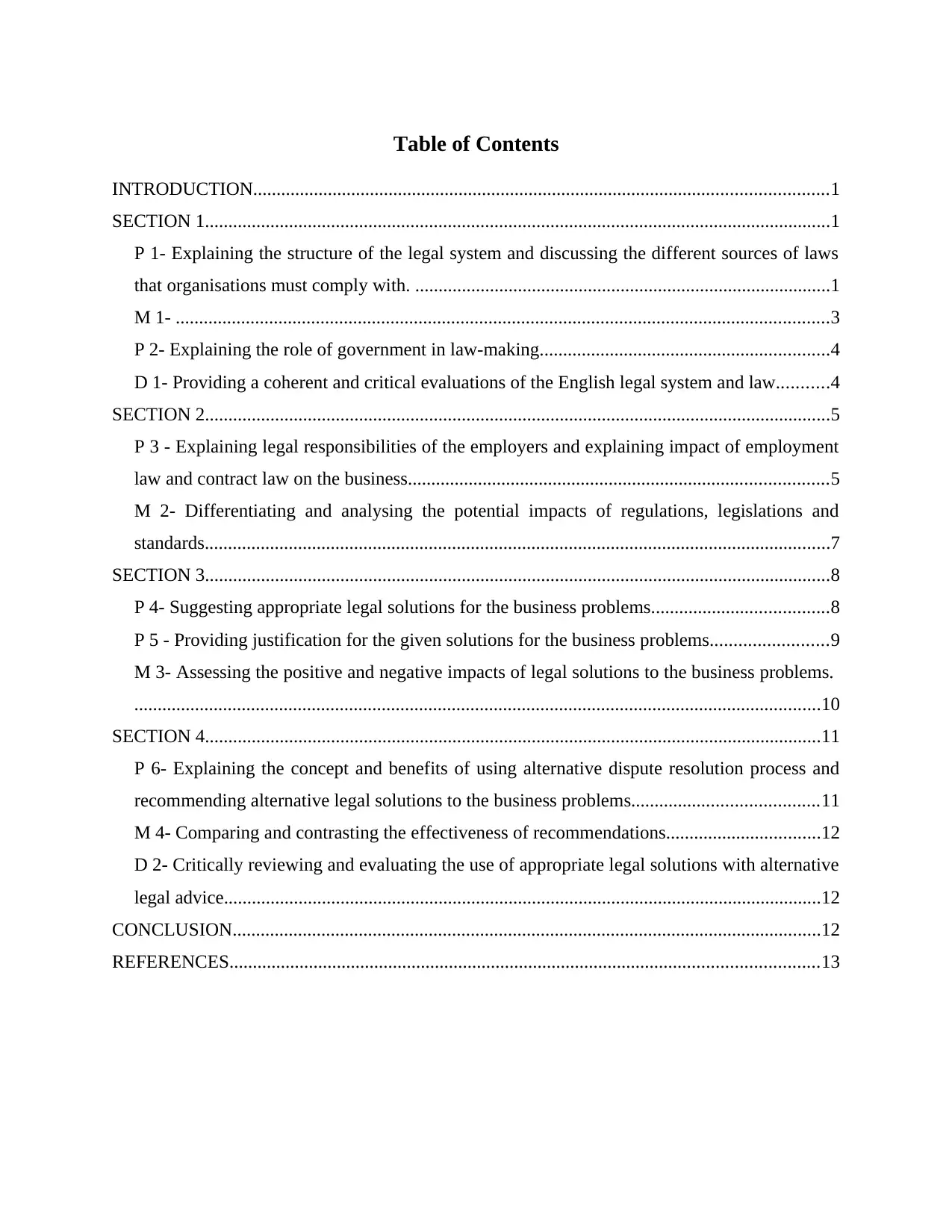
Table of Contents
INTRODUCTION...........................................................................................................................1
SECTION 1......................................................................................................................................1
P 1- Explaining the structure of the legal system and discussing the different sources of laws
that organisations must comply with. .........................................................................................1
M 1- ............................................................................................................................................3
P 2- Explaining the role of government in law-making..............................................................4
D 1- Providing a coherent and critical evaluations of the English legal system and law...........4
SECTION 2......................................................................................................................................5
P 3 - Explaining legal responsibilities of the employers and explaining impact of employment
law and contract law on the business..........................................................................................5
M 2- Differentiating and analysing the potential impacts of regulations, legislations and
standards......................................................................................................................................7
SECTION 3......................................................................................................................................8
P 4- Suggesting appropriate legal solutions for the business problems......................................8
P 5 - Providing justification for the given solutions for the business problems.........................9
M 3- Assessing the positive and negative impacts of legal solutions to the business problems.
...................................................................................................................................................10
SECTION 4....................................................................................................................................11
P 6- Explaining the concept and benefits of using alternative dispute resolution process and
recommending alternative legal solutions to the business problems........................................11
M 4- Comparing and contrasting the effectiveness of recommendations.................................12
D 2- Critically reviewing and evaluating the use of appropriate legal solutions with alternative
legal advice................................................................................................................................12
CONCLUSION..............................................................................................................................12
REFERENCES..............................................................................................................................13
INTRODUCTION...........................................................................................................................1
SECTION 1......................................................................................................................................1
P 1- Explaining the structure of the legal system and discussing the different sources of laws
that organisations must comply with. .........................................................................................1
M 1- ............................................................................................................................................3
P 2- Explaining the role of government in law-making..............................................................4
D 1- Providing a coherent and critical evaluations of the English legal system and law...........4
SECTION 2......................................................................................................................................5
P 3 - Explaining legal responsibilities of the employers and explaining impact of employment
law and contract law on the business..........................................................................................5
M 2- Differentiating and analysing the potential impacts of regulations, legislations and
standards......................................................................................................................................7
SECTION 3......................................................................................................................................8
P 4- Suggesting appropriate legal solutions for the business problems......................................8
P 5 - Providing justification for the given solutions for the business problems.........................9
M 3- Assessing the positive and negative impacts of legal solutions to the business problems.
...................................................................................................................................................10
SECTION 4....................................................................................................................................11
P 6- Explaining the concept and benefits of using alternative dispute resolution process and
recommending alternative legal solutions to the business problems........................................11
M 4- Comparing and contrasting the effectiveness of recommendations.................................12
D 2- Critically reviewing and evaluating the use of appropriate legal solutions with alternative
legal advice................................................................................................................................12
CONCLUSION..............................................................................................................................12
REFERENCES..............................................................................................................................13
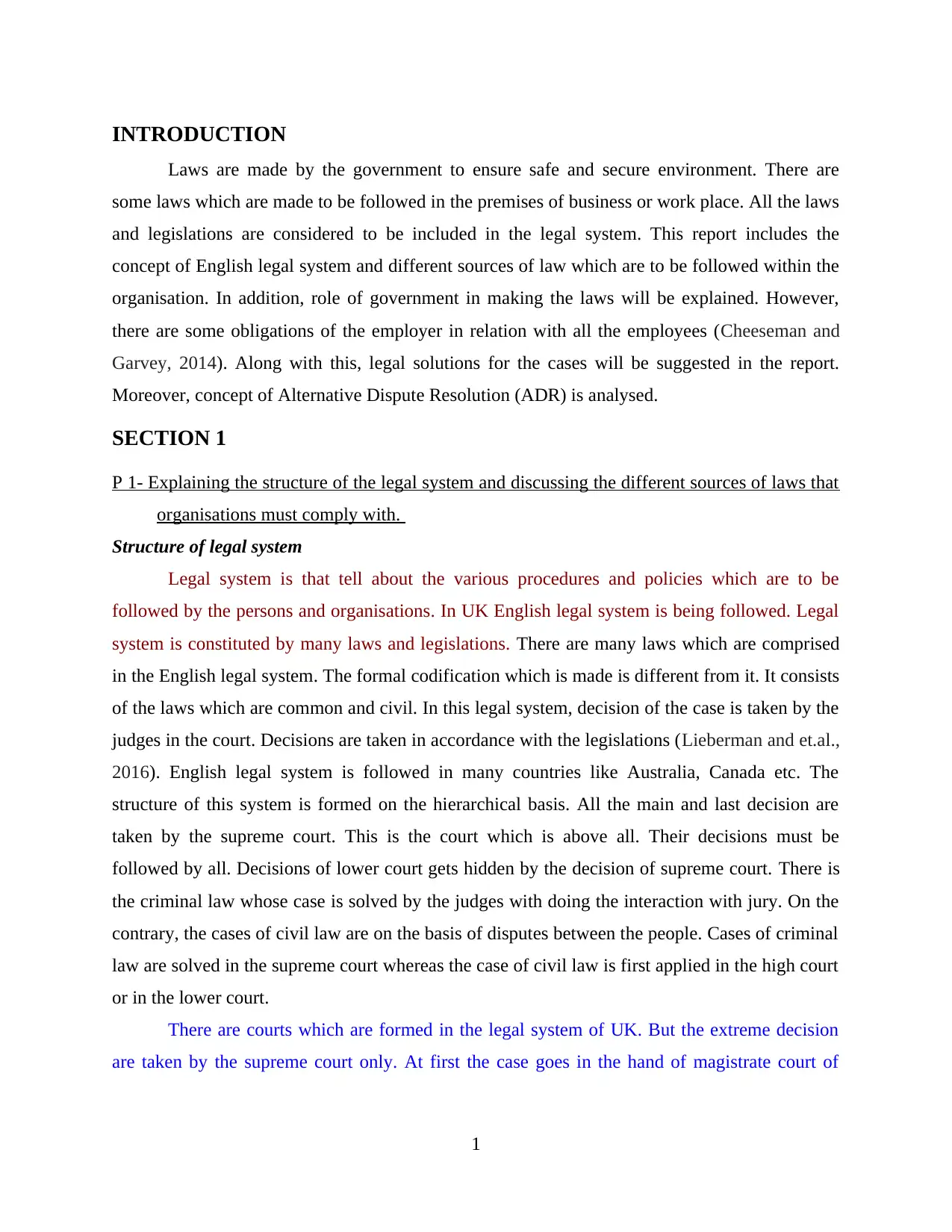
INTRODUCTION
Laws are made by the government to ensure safe and secure environment. There are
some laws which are made to be followed in the premises of business or work place. All the laws
and legislations are considered to be included in the legal system. This report includes the
concept of English legal system and different sources of law which are to be followed within the
organisation. In addition, role of government in making the laws will be explained. However,
there are some obligations of the employer in relation with all the employees (Cheeseman and
Garvey, 2014). Along with this, legal solutions for the cases will be suggested in the report.
Moreover, concept of Alternative Dispute Resolution (ADR) is analysed.
SECTION 1
P 1- Explaining the structure of the legal system and discussing the different sources of laws that
organisations must comply with.
Structure of legal system
Legal system is that tell about the various procedures and policies which are to be
followed by the persons and organisations. In UK English legal system is being followed. Legal
system is constituted by many laws and legislations. There are many laws which are comprised
in the English legal system. The formal codification which is made is different from it. It consists
of the laws which are common and civil. In this legal system, decision of the case is taken by the
judges in the court. Decisions are taken in accordance with the legislations (Lieberman and et.al.,
2016). English legal system is followed in many countries like Australia, Canada etc. The
structure of this system is formed on the hierarchical basis. All the main and last decision are
taken by the supreme court. This is the court which is above all. Their decisions must be
followed by all. Decisions of lower court gets hidden by the decision of supreme court. There is
the criminal law whose case is solved by the judges with doing the interaction with jury. On the
contrary, the cases of civil law are on the basis of disputes between the people. Cases of criminal
law are solved in the supreme court whereas the case of civil law is first applied in the high court
or in the lower court.
There are courts which are formed in the legal system of UK. But the extreme decision
are taken by the supreme court only. At first the case goes in the hand of magistrate court of
1
Laws are made by the government to ensure safe and secure environment. There are
some laws which are made to be followed in the premises of business or work place. All the laws
and legislations are considered to be included in the legal system. This report includes the
concept of English legal system and different sources of law which are to be followed within the
organisation. In addition, role of government in making the laws will be explained. However,
there are some obligations of the employer in relation with all the employees (Cheeseman and
Garvey, 2014). Along with this, legal solutions for the cases will be suggested in the report.
Moreover, concept of Alternative Dispute Resolution (ADR) is analysed.
SECTION 1
P 1- Explaining the structure of the legal system and discussing the different sources of laws that
organisations must comply with.
Structure of legal system
Legal system is that tell about the various procedures and policies which are to be
followed by the persons and organisations. In UK English legal system is being followed. Legal
system is constituted by many laws and legislations. There are many laws which are comprised
in the English legal system. The formal codification which is made is different from it. It consists
of the laws which are common and civil. In this legal system, decision of the case is taken by the
judges in the court. Decisions are taken in accordance with the legislations (Lieberman and et.al.,
2016). English legal system is followed in many countries like Australia, Canada etc. The
structure of this system is formed on the hierarchical basis. All the main and last decision are
taken by the supreme court. This is the court which is above all. Their decisions must be
followed by all. Decisions of lower court gets hidden by the decision of supreme court. There is
the criminal law whose case is solved by the judges with doing the interaction with jury. On the
contrary, the cases of civil law are on the basis of disputes between the people. Cases of criminal
law are solved in the supreme court whereas the case of civil law is first applied in the high court
or in the lower court.
There are courts which are formed in the legal system of UK. But the extreme decision
are taken by the supreme court only. At first the case goes in the hand of magistrate court of
1
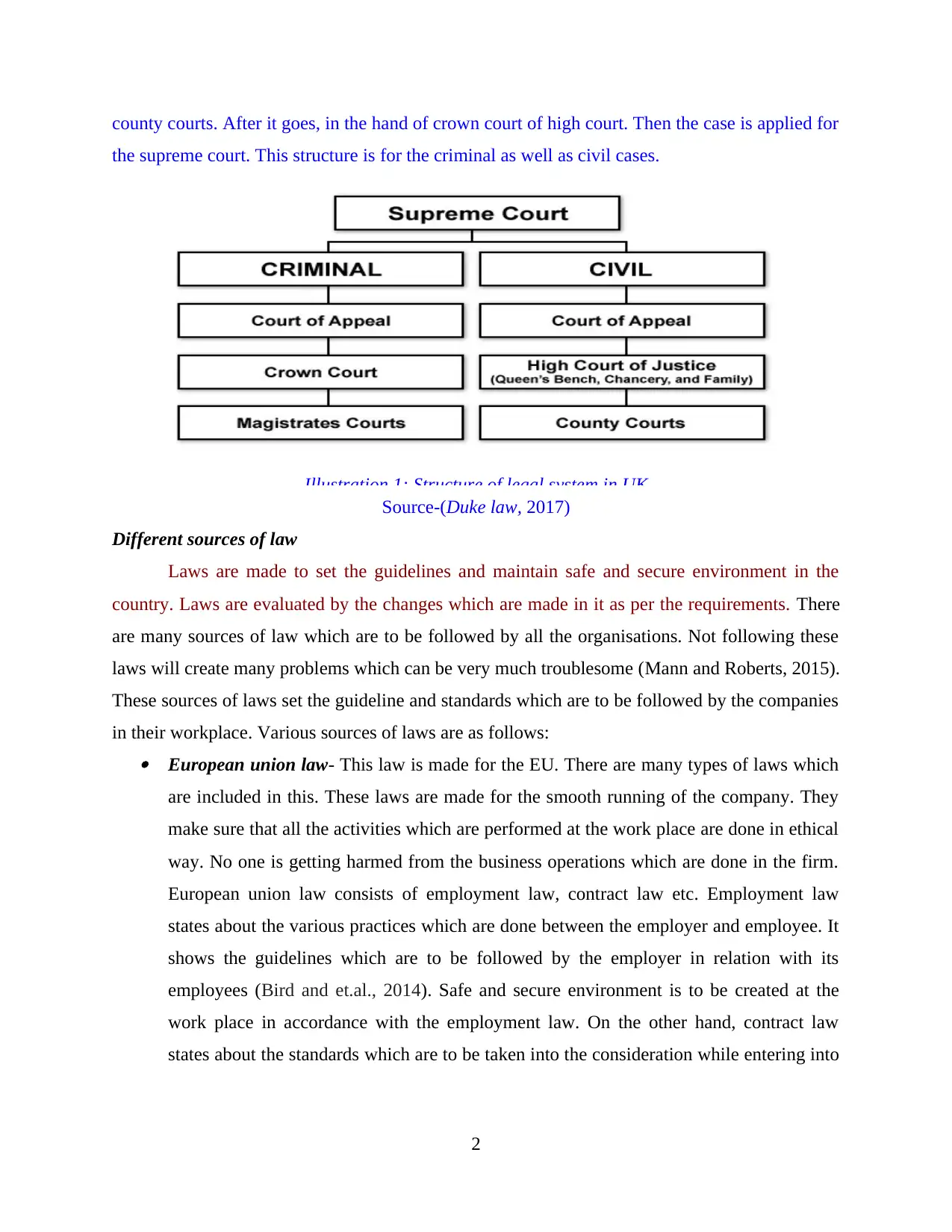
county courts. After it goes, in the hand of crown court of high court. Then the case is applied for
the supreme court. This structure is for the criminal as well as civil cases.
Illustration 1: Structure of legal system in UK
Source-(Duke law, 2017)
Different sources of law
Laws are made to set the guidelines and maintain safe and secure environment in the
country. Laws are evaluated by the changes which are made in it as per the requirements. There
are many sources of law which are to be followed by all the organisations. Not following these
laws will create many problems which can be very much troublesome (Mann and Roberts, 2015).
These sources of laws set the guideline and standards which are to be followed by the companies
in their workplace. Various sources of laws are as follows: European union law- This law is made for the EU. There are many types of laws which
are included in this. These laws are made for the smooth running of the company. They
make sure that all the activities which are performed at the work place are done in ethical
way. No one is getting harmed from the business operations which are done in the firm.
European union law consists of employment law, contract law etc. Employment law
states about the various practices which are done between the employer and employee. It
shows the guidelines which are to be followed by the employer in relation with its
employees (Bird and et.al., 2014). Safe and secure environment is to be created at the
work place in accordance with the employment law. On the other hand, contract law
states about the standards which are to be taken into the consideration while entering into
2
the supreme court. This structure is for the criminal as well as civil cases.
Illustration 1: Structure of legal system in UK
Source-(Duke law, 2017)
Different sources of law
Laws are made to set the guidelines and maintain safe and secure environment in the
country. Laws are evaluated by the changes which are made in it as per the requirements. There
are many sources of law which are to be followed by all the organisations. Not following these
laws will create many problems which can be very much troublesome (Mann and Roberts, 2015).
These sources of laws set the guideline and standards which are to be followed by the companies
in their workplace. Various sources of laws are as follows: European union law- This law is made for the EU. There are many types of laws which
are included in this. These laws are made for the smooth running of the company. They
make sure that all the activities which are performed at the work place are done in ethical
way. No one is getting harmed from the business operations which are done in the firm.
European union law consists of employment law, contract law etc. Employment law
states about the various practices which are done between the employer and employee. It
shows the guidelines which are to be followed by the employer in relation with its
employees (Bird and et.al., 2014). Safe and secure environment is to be created at the
work place in accordance with the employment law. On the other hand, contract law
states about the standards which are to be taken into the consideration while entering into
2
Secure Best Marks with AI Grader
Need help grading? Try our AI Grader for instant feedback on your assignments.
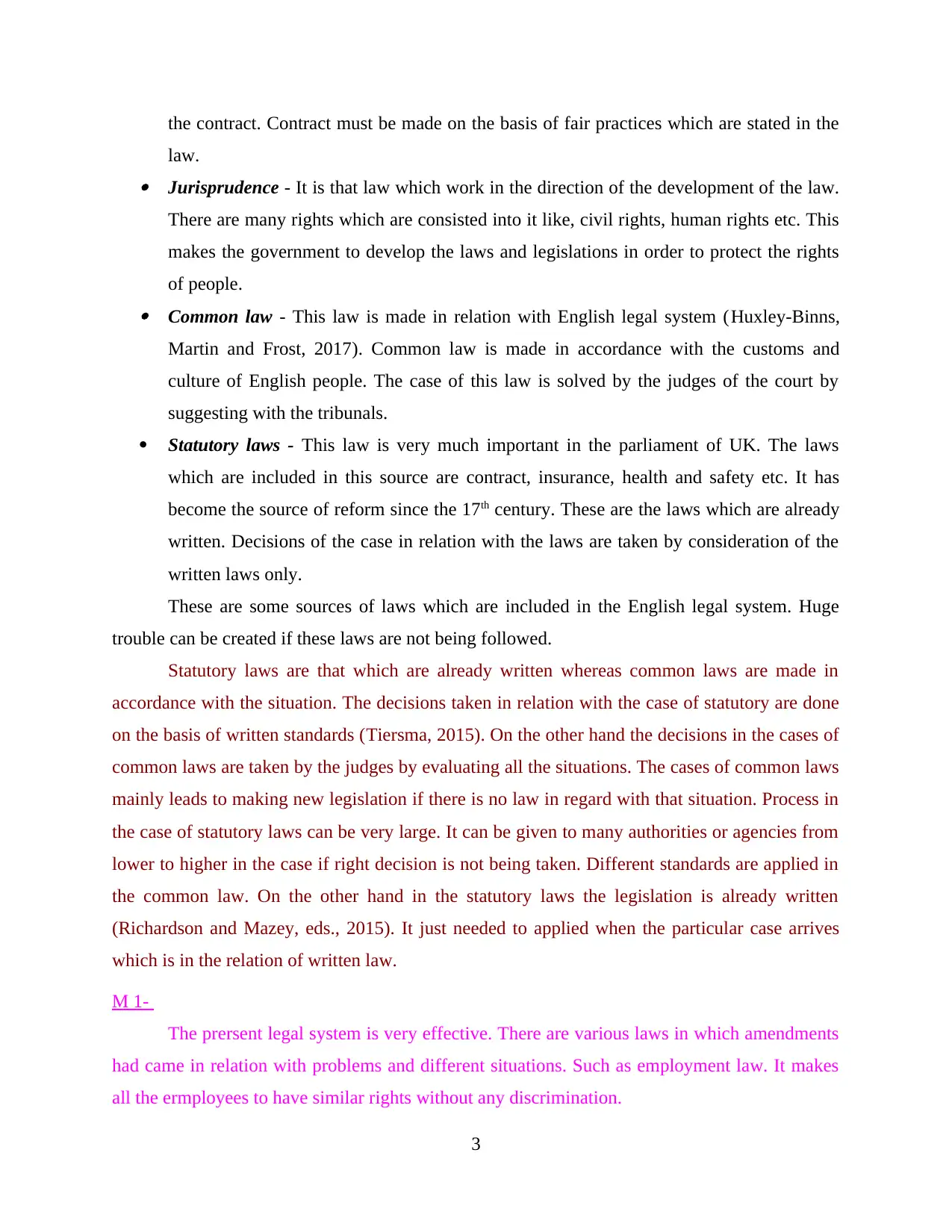
the contract. Contract must be made on the basis of fair practices which are stated in the
law. Jurisprudence - It is that law which work in the direction of the development of the law.
There are many rights which are consisted into it like, civil rights, human rights etc. This
makes the government to develop the laws and legislations in order to protect the rights
of people. Common law - This law is made in relation with English legal system (Huxley-Binns,
Martin and Frost, 2017). Common law is made in accordance with the customs and
culture of English people. The case of this law is solved by the judges of the court by
suggesting with the tribunals.
Statutory laws - This law is very much important in the parliament of UK. The laws
which are included in this source are contract, insurance, health and safety etc. It has
become the source of reform since the 17th century. These are the laws which are already
written. Decisions of the case in relation with the laws are taken by consideration of the
written laws only.
These are some sources of laws which are included in the English legal system. Huge
trouble can be created if these laws are not being followed.
Statutory laws are that which are already written whereas common laws are made in
accordance with the situation. The decisions taken in relation with the case of statutory are done
on the basis of written standards (Tiersma, 2015). On the other hand the decisions in the cases of
common laws are taken by the judges by evaluating all the situations. The cases of common laws
mainly leads to making new legislation if there is no law in regard with that situation. Process in
the case of statutory laws can be very large. It can be given to many authorities or agencies from
lower to higher in the case if right decision is not being taken. Different standards are applied in
the common law. On the other hand in the statutory laws the legislation is already written
(Richardson and Mazey, eds., 2015). It just needed to applied when the particular case arrives
which is in the relation of written law.
M 1-
The prersent legal system is very effective. There are various laws in which amendments
had came in relation with problems and different situations. Such as employment law. It makes
all the ermployees to have similar rights without any discrimination.
3
law. Jurisprudence - It is that law which work in the direction of the development of the law.
There are many rights which are consisted into it like, civil rights, human rights etc. This
makes the government to develop the laws and legislations in order to protect the rights
of people. Common law - This law is made in relation with English legal system (Huxley-Binns,
Martin and Frost, 2017). Common law is made in accordance with the customs and
culture of English people. The case of this law is solved by the judges of the court by
suggesting with the tribunals.
Statutory laws - This law is very much important in the parliament of UK. The laws
which are included in this source are contract, insurance, health and safety etc. It has
become the source of reform since the 17th century. These are the laws which are already
written. Decisions of the case in relation with the laws are taken by consideration of the
written laws only.
These are some sources of laws which are included in the English legal system. Huge
trouble can be created if these laws are not being followed.
Statutory laws are that which are already written whereas common laws are made in
accordance with the situation. The decisions taken in relation with the case of statutory are done
on the basis of written standards (Tiersma, 2015). On the other hand the decisions in the cases of
common laws are taken by the judges by evaluating all the situations. The cases of common laws
mainly leads to making new legislation if there is no law in regard with that situation. Process in
the case of statutory laws can be very large. It can be given to many authorities or agencies from
lower to higher in the case if right decision is not being taken. Different standards are applied in
the common law. On the other hand in the statutory laws the legislation is already written
(Richardson and Mazey, eds., 2015). It just needed to applied when the particular case arrives
which is in the relation of written law.
M 1-
The prersent legal system is very effective. There are various laws in which amendments
had came in relation with problems and different situations. Such as employment law. It makes
all the ermployees to have similar rights without any discrimination.
3
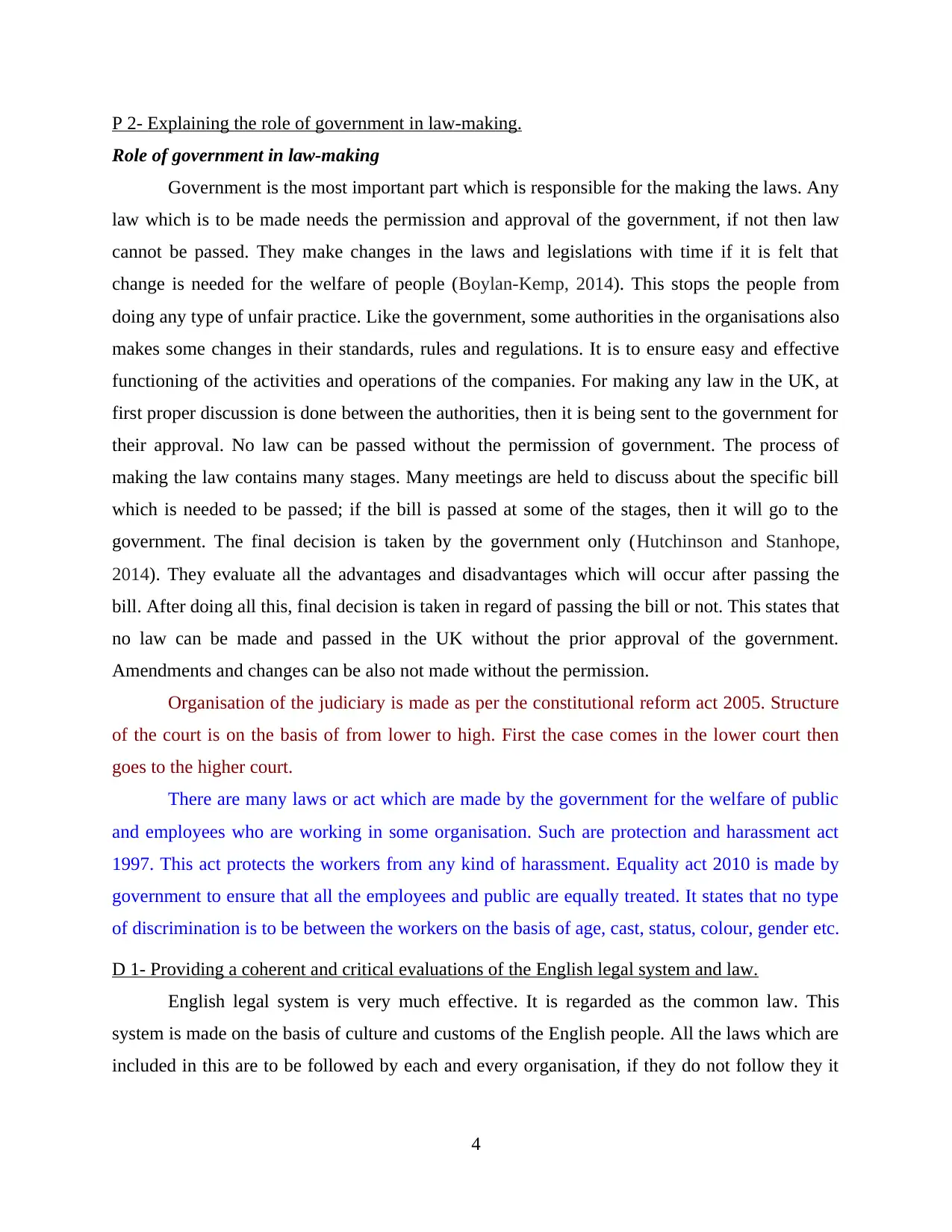
P 2- Explaining the role of government in law-making.
Role of government in law-making
Government is the most important part which is responsible for the making the laws. Any
law which is to be made needs the permission and approval of the government, if not then law
cannot be passed. They make changes in the laws and legislations with time if it is felt that
change is needed for the welfare of people (Boylan-Kemp, 2014). This stops the people from
doing any type of unfair practice. Like the government, some authorities in the organisations also
makes some changes in their standards, rules and regulations. It is to ensure easy and effective
functioning of the activities and operations of the companies. For making any law in the UK, at
first proper discussion is done between the authorities, then it is being sent to the government for
their approval. No law can be passed without the permission of government. The process of
making the law contains many stages. Many meetings are held to discuss about the specific bill
which is needed to be passed; if the bill is passed at some of the stages, then it will go to the
government. The final decision is taken by the government only (Hutchinson and Stanhope,
2014). They evaluate all the advantages and disadvantages which will occur after passing the
bill. After doing all this, final decision is taken in regard of passing the bill or not. This states that
no law can be made and passed in the UK without the prior approval of the government.
Amendments and changes can be also not made without the permission.
Organisation of the judiciary is made as per the constitutional reform act 2005. Structure
of the court is on the basis of from lower to high. First the case comes in the lower court then
goes to the higher court.
There are many laws or act which are made by the government for the welfare of public
and employees who are working in some organisation. Such are protection and harassment act
1997. This act protects the workers from any kind of harassment. Equality act 2010 is made by
government to ensure that all the employees and public are equally treated. It states that no type
of discrimination is to be between the workers on the basis of age, cast, status, colour, gender etc.
D 1- Providing a coherent and critical evaluations of the English legal system and law.
English legal system is very much effective. It is regarded as the common law. This
system is made on the basis of culture and customs of the English people. All the laws which are
included in this are to be followed by each and every organisation, if they do not follow they it
4
Role of government in law-making
Government is the most important part which is responsible for the making the laws. Any
law which is to be made needs the permission and approval of the government, if not then law
cannot be passed. They make changes in the laws and legislations with time if it is felt that
change is needed for the welfare of people (Boylan-Kemp, 2014). This stops the people from
doing any type of unfair practice. Like the government, some authorities in the organisations also
makes some changes in their standards, rules and regulations. It is to ensure easy and effective
functioning of the activities and operations of the companies. For making any law in the UK, at
first proper discussion is done between the authorities, then it is being sent to the government for
their approval. No law can be passed without the permission of government. The process of
making the law contains many stages. Many meetings are held to discuss about the specific bill
which is needed to be passed; if the bill is passed at some of the stages, then it will go to the
government. The final decision is taken by the government only (Hutchinson and Stanhope,
2014). They evaluate all the advantages and disadvantages which will occur after passing the
bill. After doing all this, final decision is taken in regard of passing the bill or not. This states that
no law can be made and passed in the UK without the prior approval of the government.
Amendments and changes can be also not made without the permission.
Organisation of the judiciary is made as per the constitutional reform act 2005. Structure
of the court is on the basis of from lower to high. First the case comes in the lower court then
goes to the higher court.
There are many laws or act which are made by the government for the welfare of public
and employees who are working in some organisation. Such are protection and harassment act
1997. This act protects the workers from any kind of harassment. Equality act 2010 is made by
government to ensure that all the employees and public are equally treated. It states that no type
of discrimination is to be between the workers on the basis of age, cast, status, colour, gender etc.
D 1- Providing a coherent and critical evaluations of the English legal system and law.
English legal system is very much effective. It is regarded as the common law. This
system is made on the basis of culture and customs of the English people. All the laws which are
included in this are to be followed by each and every organisation, if they do not follow they it
4
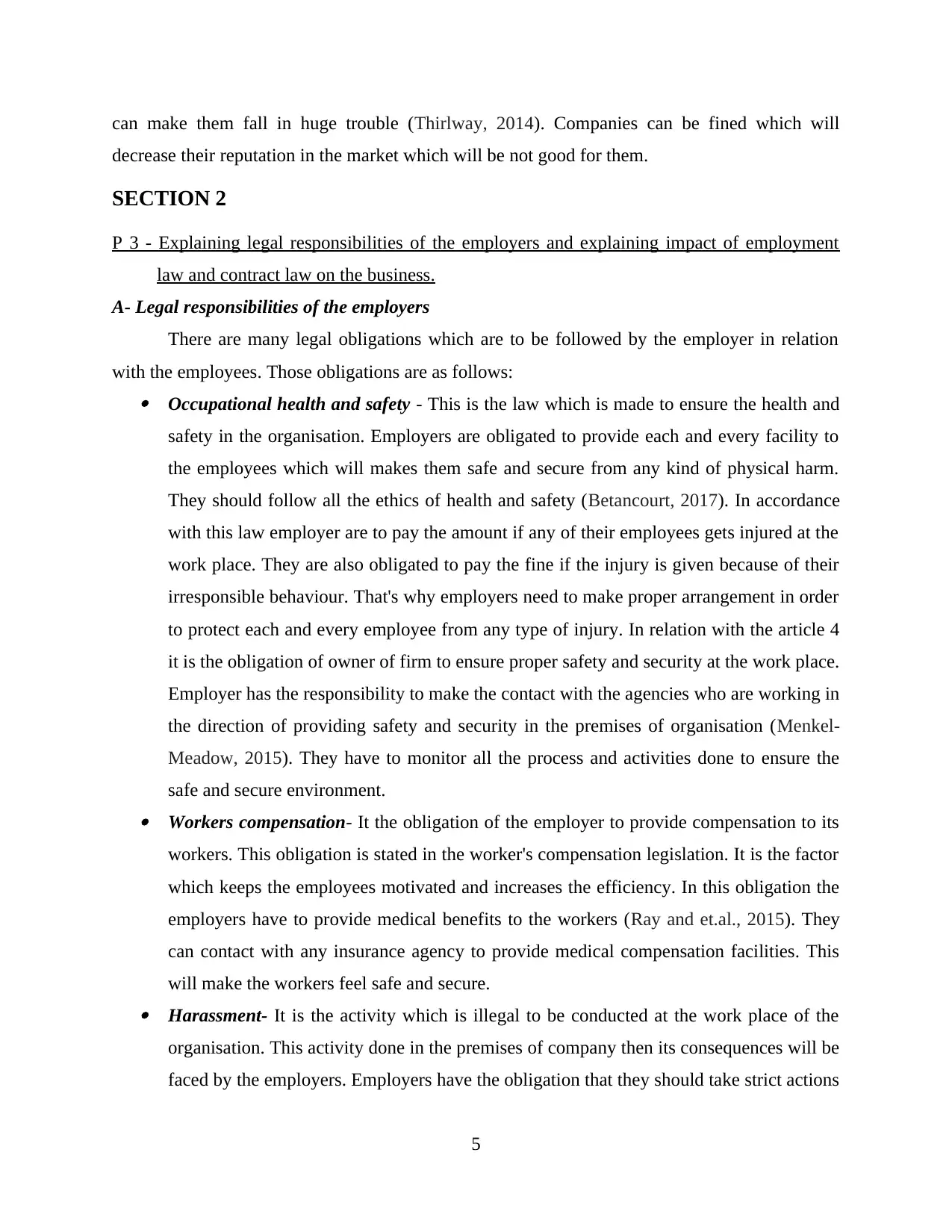
can make them fall in huge trouble (Thirlway, 2014). Companies can be fined which will
decrease their reputation in the market which will be not good for them.
SECTION 2
P 3 - Explaining legal responsibilities of the employers and explaining impact of employment
law and contract law on the business.
A- Legal responsibilities of the employers
There are many legal obligations which are to be followed by the employer in relation
with the employees. Those obligations are as follows: Occupational health and safety - This is the law which is made to ensure the health and
safety in the organisation. Employers are obligated to provide each and every facility to
the employees which will makes them safe and secure from any kind of physical harm.
They should follow all the ethics of health and safety (Betancourt, 2017). In accordance
with this law employer are to pay the amount if any of their employees gets injured at the
work place. They are also obligated to pay the fine if the injury is given because of their
irresponsible behaviour. That's why employers need to make proper arrangement in order
to protect each and every employee from any type of injury. In relation with the article 4
it is the obligation of owner of firm to ensure proper safety and security at the work place.
Employer has the responsibility to make the contact with the agencies who are working in
the direction of providing safety and security in the premises of organisation (Menkel-
Meadow, 2015). They have to monitor all the process and activities done to ensure the
safe and secure environment. Workers compensation- It the obligation of the employer to provide compensation to its
workers. This obligation is stated in the worker's compensation legislation. It is the factor
which keeps the employees motivated and increases the efficiency. In this obligation the
employers have to provide medical benefits to the workers (Ray and et.al., 2015). They
can contact with any insurance agency to provide medical compensation facilities. This
will make the workers feel safe and secure. Harassment- It is the activity which is illegal to be conducted at the work place of the
organisation. This activity done in the premises of company then its consequences will be
faced by the employers. Employers have the obligation that they should take strict actions
5
decrease their reputation in the market which will be not good for them.
SECTION 2
P 3 - Explaining legal responsibilities of the employers and explaining impact of employment
law and contract law on the business.
A- Legal responsibilities of the employers
There are many legal obligations which are to be followed by the employer in relation
with the employees. Those obligations are as follows: Occupational health and safety - This is the law which is made to ensure the health and
safety in the organisation. Employers are obligated to provide each and every facility to
the employees which will makes them safe and secure from any kind of physical harm.
They should follow all the ethics of health and safety (Betancourt, 2017). In accordance
with this law employer are to pay the amount if any of their employees gets injured at the
work place. They are also obligated to pay the fine if the injury is given because of their
irresponsible behaviour. That's why employers need to make proper arrangement in order
to protect each and every employee from any type of injury. In relation with the article 4
it is the obligation of owner of firm to ensure proper safety and security at the work place.
Employer has the responsibility to make the contact with the agencies who are working in
the direction of providing safety and security in the premises of organisation (Menkel-
Meadow, 2015). They have to monitor all the process and activities done to ensure the
safe and secure environment. Workers compensation- It the obligation of the employer to provide compensation to its
workers. This obligation is stated in the worker's compensation legislation. It is the factor
which keeps the employees motivated and increases the efficiency. In this obligation the
employers have to provide medical benefits to the workers (Ray and et.al., 2015). They
can contact with any insurance agency to provide medical compensation facilities. This
will make the workers feel safe and secure. Harassment- It is the activity which is illegal to be conducted at the work place of the
organisation. This activity done in the premises of company then its consequences will be
faced by the employers. Employers have the obligation that they should take strict actions
5
Paraphrase This Document
Need a fresh take? Get an instant paraphrase of this document with our AI Paraphraser
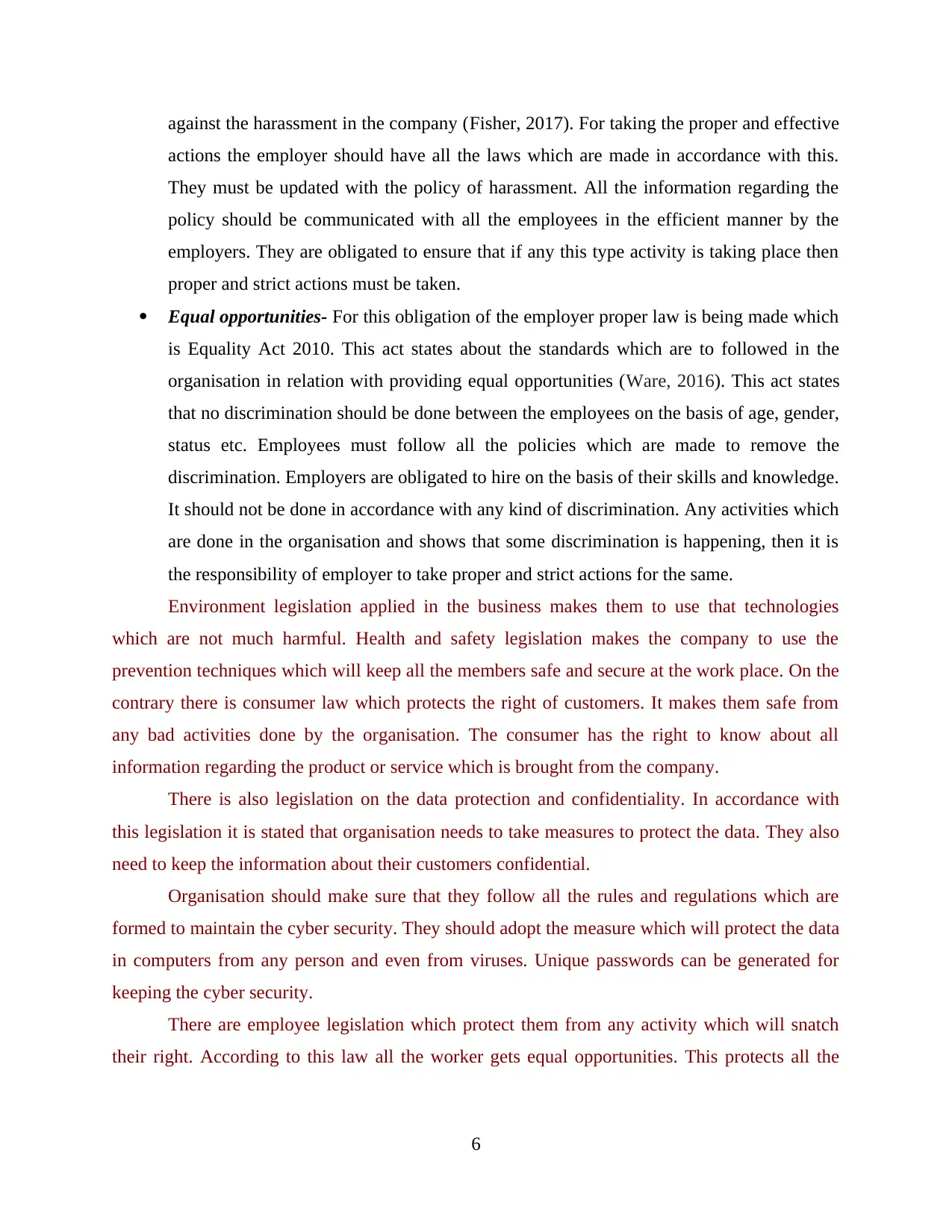
against the harassment in the company (Fisher, 2017). For taking the proper and effective
actions the employer should have all the laws which are made in accordance with this.
They must be updated with the policy of harassment. All the information regarding the
policy should be communicated with all the employees in the efficient manner by the
employers. They are obligated to ensure that if any this type activity is taking place then
proper and strict actions must be taken.
Equal opportunities- For this obligation of the employer proper law is being made which
is Equality Act 2010. This act states about the standards which are to followed in the
organisation in relation with providing equal opportunities (Ware, 2016). This act states
that no discrimination should be done between the employees on the basis of age, gender,
status etc. Employees must follow all the policies which are made to remove the
discrimination. Employers are obligated to hire on the basis of their skills and knowledge.
It should not be done in accordance with any kind of discrimination. Any activities which
are done in the organisation and shows that some discrimination is happening, then it is
the responsibility of employer to take proper and strict actions for the same.
Environment legislation applied in the business makes them to use that technologies
which are not much harmful. Health and safety legislation makes the company to use the
prevention techniques which will keep all the members safe and secure at the work place. On the
contrary there is consumer law which protects the right of customers. It makes them safe from
any bad activities done by the organisation. The consumer has the right to know about all
information regarding the product or service which is brought from the company.
There is also legislation on the data protection and confidentiality. In accordance with
this legislation it is stated that organisation needs to take measures to protect the data. They also
need to keep the information about their customers confidential.
Organisation should make sure that they follow all the rules and regulations which are
formed to maintain the cyber security. They should adopt the measure which will protect the data
in computers from any person and even from viruses. Unique passwords can be generated for
keeping the cyber security.
There are employee legislation which protect them from any activity which will snatch
their right. According to this law all the worker gets equal opportunities. This protects all the
6
actions the employer should have all the laws which are made in accordance with this.
They must be updated with the policy of harassment. All the information regarding the
policy should be communicated with all the employees in the efficient manner by the
employers. They are obligated to ensure that if any this type activity is taking place then
proper and strict actions must be taken.
Equal opportunities- For this obligation of the employer proper law is being made which
is Equality Act 2010. This act states about the standards which are to followed in the
organisation in relation with providing equal opportunities (Ware, 2016). This act states
that no discrimination should be done between the employees on the basis of age, gender,
status etc. Employees must follow all the policies which are made to remove the
discrimination. Employers are obligated to hire on the basis of their skills and knowledge.
It should not be done in accordance with any kind of discrimination. Any activities which
are done in the organisation and shows that some discrimination is happening, then it is
the responsibility of employer to take proper and strict actions for the same.
Environment legislation applied in the business makes them to use that technologies
which are not much harmful. Health and safety legislation makes the company to use the
prevention techniques which will keep all the members safe and secure at the work place. On the
contrary there is consumer law which protects the right of customers. It makes them safe from
any bad activities done by the organisation. The consumer has the right to know about all
information regarding the product or service which is brought from the company.
There is also legislation on the data protection and confidentiality. In accordance with
this legislation it is stated that organisation needs to take measures to protect the data. They also
need to keep the information about their customers confidential.
Organisation should make sure that they follow all the rules and regulations which are
formed to maintain the cyber security. They should adopt the measure which will protect the data
in computers from any person and even from viruses. Unique passwords can be generated for
keeping the cyber security.
There are employee legislation which protect them from any activity which will snatch
their right. According to this law all the worker gets equal opportunities. This protects all the
6
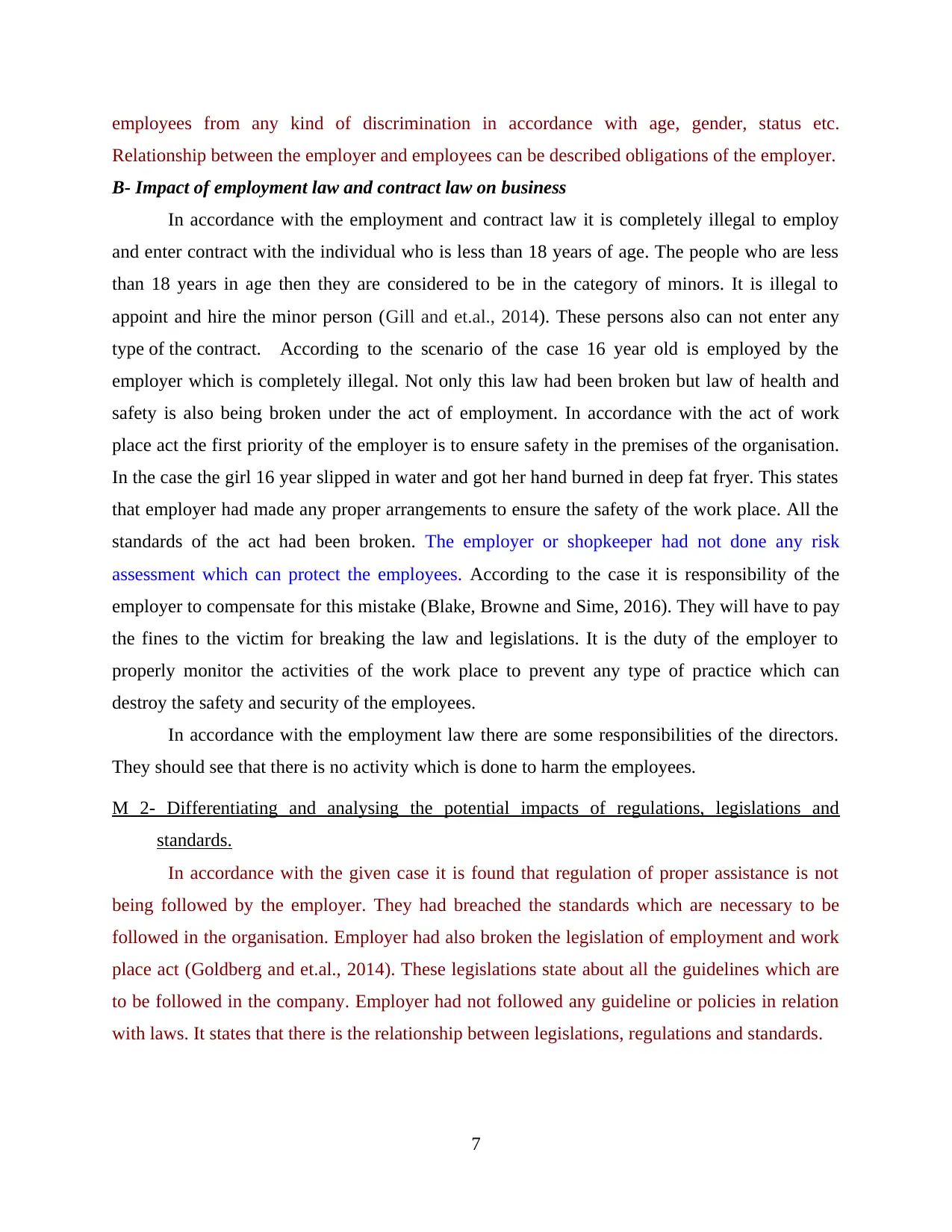
employees from any kind of discrimination in accordance with age, gender, status etc.
Relationship between the employer and employees can be described obligations of the employer.
B- Impact of employment law and contract law on business
In accordance with the employment and contract law it is completely illegal to employ
and enter contract with the individual who is less than 18 years of age. The people who are less
than 18 years in age then they are considered to be in the category of minors. It is illegal to
appoint and hire the minor person (Gill and et.al., 2014). These persons also can not enter any
type of the contract. According to the scenario of the case 16 year old is employed by the
employer which is completely illegal. Not only this law had been broken but law of health and
safety is also being broken under the act of employment. In accordance with the act of work
place act the first priority of the employer is to ensure safety in the premises of the organisation.
In the case the girl 16 year slipped in water and got her hand burned in deep fat fryer. This states
that employer had made any proper arrangements to ensure the safety of the work place. All the
standards of the act had been broken. The employer or shopkeeper had not done any risk
assessment which can protect the employees. According to the case it is responsibility of the
employer to compensate for this mistake (Blake, Browne and Sime, 2016). They will have to pay
the fines to the victim for breaking the law and legislations. It is the duty of the employer to
properly monitor the activities of the work place to prevent any type of practice which can
destroy the safety and security of the employees.
In accordance with the employment law there are some responsibilities of the directors.
They should see that there is no activity which is done to harm the employees.
M 2- Differentiating and analysing the potential impacts of regulations, legislations and
standards.
In accordance with the given case it is found that regulation of proper assistance is not
being followed by the employer. They had breached the standards which are necessary to be
followed in the organisation. Employer had also broken the legislation of employment and work
place act (Goldberg and et.al., 2014). These legislations state about all the guidelines which are
to be followed in the company. Employer had not followed any guideline or policies in relation
with laws. It states that there is the relationship between legislations, regulations and standards.
7
Relationship between the employer and employees can be described obligations of the employer.
B- Impact of employment law and contract law on business
In accordance with the employment and contract law it is completely illegal to employ
and enter contract with the individual who is less than 18 years of age. The people who are less
than 18 years in age then they are considered to be in the category of minors. It is illegal to
appoint and hire the minor person (Gill and et.al., 2014). These persons also can not enter any
type of the contract. According to the scenario of the case 16 year old is employed by the
employer which is completely illegal. Not only this law had been broken but law of health and
safety is also being broken under the act of employment. In accordance with the act of work
place act the first priority of the employer is to ensure safety in the premises of the organisation.
In the case the girl 16 year slipped in water and got her hand burned in deep fat fryer. This states
that employer had made any proper arrangements to ensure the safety of the work place. All the
standards of the act had been broken. The employer or shopkeeper had not done any risk
assessment which can protect the employees. According to the case it is responsibility of the
employer to compensate for this mistake (Blake, Browne and Sime, 2016). They will have to pay
the fines to the victim for breaking the law and legislations. It is the duty of the employer to
properly monitor the activities of the work place to prevent any type of practice which can
destroy the safety and security of the employees.
In accordance with the employment law there are some responsibilities of the directors.
They should see that there is no activity which is done to harm the employees.
M 2- Differentiating and analysing the potential impacts of regulations, legislations and
standards.
In accordance with the given case it is found that regulation of proper assistance is not
being followed by the employer. They had breached the standards which are necessary to be
followed in the organisation. Employer had also broken the legislation of employment and work
place act (Goldberg and et.al., 2014). These legislations state about all the guidelines which are
to be followed in the company. Employer had not followed any guideline or policies in relation
with laws. It states that there is the relationship between legislations, regulations and standards.
7
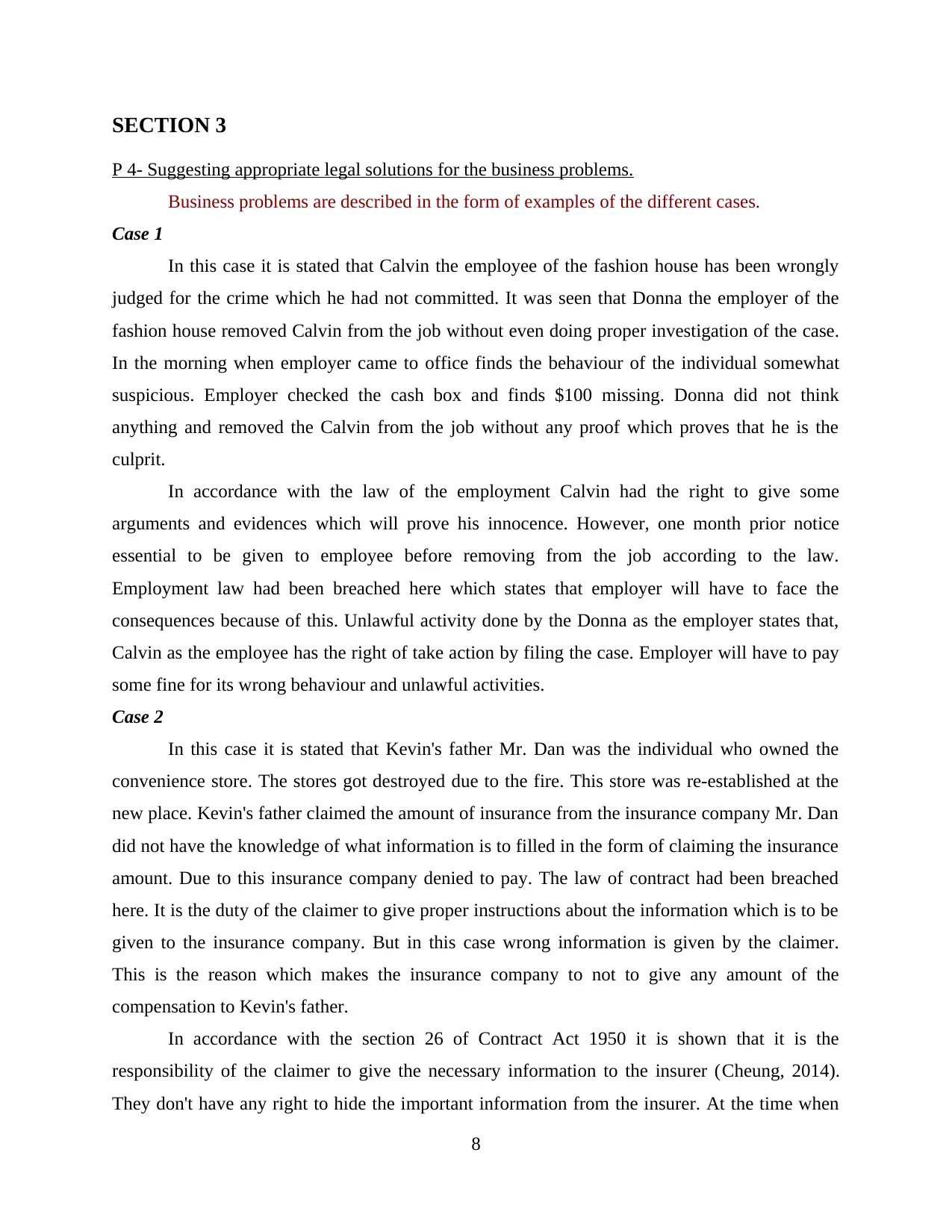
SECTION 3
P 4- Suggesting appropriate legal solutions for the business problems.
Business problems are described in the form of examples of the different cases.
Case 1
In this case it is stated that Calvin the employee of the fashion house has been wrongly
judged for the crime which he had not committed. It was seen that Donna the employer of the
fashion house removed Calvin from the job without even doing proper investigation of the case.
In the morning when employer came to office finds the behaviour of the individual somewhat
suspicious. Employer checked the cash box and finds $100 missing. Donna did not think
anything and removed the Calvin from the job without any proof which proves that he is the
culprit.
In accordance with the law of the employment Calvin had the right to give some
arguments and evidences which will prove his innocence. However, one month prior notice
essential to be given to employee before removing from the job according to the law.
Employment law had been breached here which states that employer will have to face the
consequences because of this. Unlawful activity done by the Donna as the employer states that,
Calvin as the employee has the right of take action by filing the case. Employer will have to pay
some fine for its wrong behaviour and unlawful activities.
Case 2
In this case it is stated that Kevin's father Mr. Dan was the individual who owned the
convenience store. The stores got destroyed due to the fire. This store was re-established at the
new place. Kevin's father claimed the amount of insurance from the insurance company Mr. Dan
did not have the knowledge of what information is to filled in the form of claiming the insurance
amount. Due to this insurance company denied to pay. The law of contract had been breached
here. It is the duty of the claimer to give proper instructions about the information which is to be
given to the insurance company. But in this case wrong information is given by the claimer.
This is the reason which makes the insurance company to not to give any amount of the
compensation to Kevin's father.
In accordance with the section 26 of Contract Act 1950 it is shown that it is the
responsibility of the claimer to give the necessary information to the insurer (Cheung, 2014).
They don't have any right to hide the important information from the insurer. At the time when
8
P 4- Suggesting appropriate legal solutions for the business problems.
Business problems are described in the form of examples of the different cases.
Case 1
In this case it is stated that Calvin the employee of the fashion house has been wrongly
judged for the crime which he had not committed. It was seen that Donna the employer of the
fashion house removed Calvin from the job without even doing proper investigation of the case.
In the morning when employer came to office finds the behaviour of the individual somewhat
suspicious. Employer checked the cash box and finds $100 missing. Donna did not think
anything and removed the Calvin from the job without any proof which proves that he is the
culprit.
In accordance with the law of the employment Calvin had the right to give some
arguments and evidences which will prove his innocence. However, one month prior notice
essential to be given to employee before removing from the job according to the law.
Employment law had been breached here which states that employer will have to face the
consequences because of this. Unlawful activity done by the Donna as the employer states that,
Calvin as the employee has the right of take action by filing the case. Employer will have to pay
some fine for its wrong behaviour and unlawful activities.
Case 2
In this case it is stated that Kevin's father Mr. Dan was the individual who owned the
convenience store. The stores got destroyed due to the fire. This store was re-established at the
new place. Kevin's father claimed the amount of insurance from the insurance company Mr. Dan
did not have the knowledge of what information is to filled in the form of claiming the insurance
amount. Due to this insurance company denied to pay. The law of contract had been breached
here. It is the duty of the claimer to give proper instructions about the information which is to be
given to the insurance company. But in this case wrong information is given by the claimer.
This is the reason which makes the insurance company to not to give any amount of the
compensation to Kevin's father.
In accordance with the section 26 of Contract Act 1950 it is shown that it is the
responsibility of the claimer to give the necessary information to the insurer (Cheung, 2014).
They don't have any right to hide the important information from the insurer. At the time when
8
Secure Best Marks with AI Grader
Need help grading? Try our AI Grader for instant feedback on your assignments.
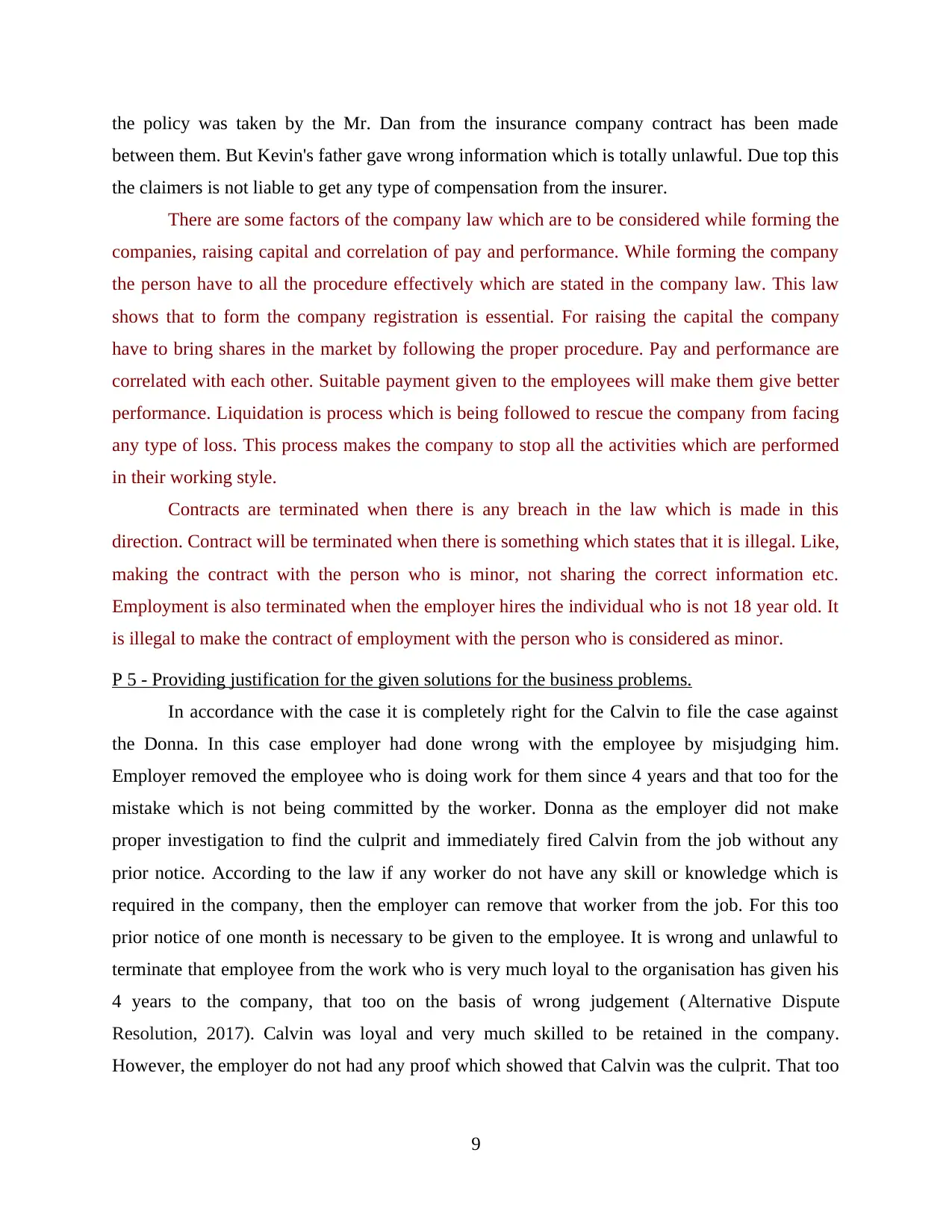
the policy was taken by the Mr. Dan from the insurance company contract has been made
between them. But Kevin's father gave wrong information which is totally unlawful. Due top this
the claimers is not liable to get any type of compensation from the insurer.
There are some factors of the company law which are to be considered while forming the
companies, raising capital and correlation of pay and performance. While forming the company
the person have to all the procedure effectively which are stated in the company law. This law
shows that to form the company registration is essential. For raising the capital the company
have to bring shares in the market by following the proper procedure. Pay and performance are
correlated with each other. Suitable payment given to the employees will make them give better
performance. Liquidation is process which is being followed to rescue the company from facing
any type of loss. This process makes the company to stop all the activities which are performed
in their working style.
Contracts are terminated when there is any breach in the law which is made in this
direction. Contract will be terminated when there is something which states that it is illegal. Like,
making the contract with the person who is minor, not sharing the correct information etc.
Employment is also terminated when the employer hires the individual who is not 18 year old. It
is illegal to make the contract of employment with the person who is considered as minor.
P 5 - Providing justification for the given solutions for the business problems.
In accordance with the case it is completely right for the Calvin to file the case against
the Donna. In this case employer had done wrong with the employee by misjudging him.
Employer removed the employee who is doing work for them since 4 years and that too for the
mistake which is not being committed by the worker. Donna as the employer did not make
proper investigation to find the culprit and immediately fired Calvin from the job without any
prior notice. According to the law if any worker do not have any skill or knowledge which is
required in the company, then the employer can remove that worker from the job. For this too
prior notice of one month is necessary to be given to the employee. It is wrong and unlawful to
terminate that employee from the work who is very much loyal to the organisation has given his
4 years to the company, that too on the basis of wrong judgement (Alternative Dispute
Resolution, 2017). Calvin was loyal and very much skilled to be retained in the company.
However, the employer do not had any proof which showed that Calvin was the culprit. That too
9
between them. But Kevin's father gave wrong information which is totally unlawful. Due top this
the claimers is not liable to get any type of compensation from the insurer.
There are some factors of the company law which are to be considered while forming the
companies, raising capital and correlation of pay and performance. While forming the company
the person have to all the procedure effectively which are stated in the company law. This law
shows that to form the company registration is essential. For raising the capital the company
have to bring shares in the market by following the proper procedure. Pay and performance are
correlated with each other. Suitable payment given to the employees will make them give better
performance. Liquidation is process which is being followed to rescue the company from facing
any type of loss. This process makes the company to stop all the activities which are performed
in their working style.
Contracts are terminated when there is any breach in the law which is made in this
direction. Contract will be terminated when there is something which states that it is illegal. Like,
making the contract with the person who is minor, not sharing the correct information etc.
Employment is also terminated when the employer hires the individual who is not 18 year old. It
is illegal to make the contract of employment with the person who is considered as minor.
P 5 - Providing justification for the given solutions for the business problems.
In accordance with the case it is completely right for the Calvin to file the case against
the Donna. In this case employer had done wrong with the employee by misjudging him.
Employer removed the employee who is doing work for them since 4 years and that too for the
mistake which is not being committed by the worker. Donna as the employer did not make
proper investigation to find the culprit and immediately fired Calvin from the job without any
prior notice. According to the law if any worker do not have any skill or knowledge which is
required in the company, then the employer can remove that worker from the job. For this too
prior notice of one month is necessary to be given to the employee. It is wrong and unlawful to
terminate that employee from the work who is very much loyal to the organisation has given his
4 years to the company, that too on the basis of wrong judgement (Alternative Dispute
Resolution, 2017). Calvin was loyal and very much skilled to be retained in the company.
However, the employer do not had any proof which showed that Calvin was the culprit. That too
9
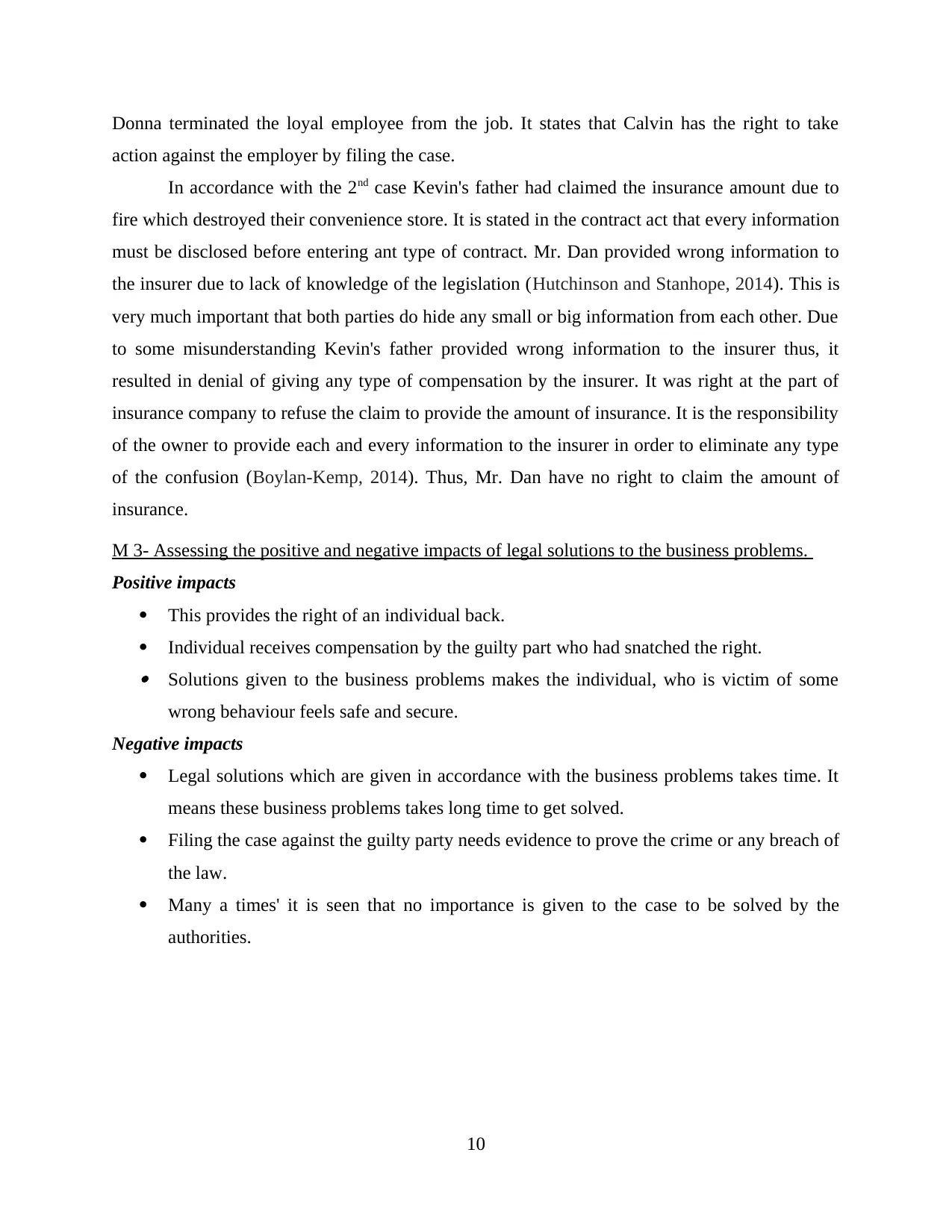
Donna terminated the loyal employee from the job. It states that Calvin has the right to take
action against the employer by filing the case.
In accordance with the 2nd case Kevin's father had claimed the insurance amount due to
fire which destroyed their convenience store. It is stated in the contract act that every information
must be disclosed before entering ant type of contract. Mr. Dan provided wrong information to
the insurer due to lack of knowledge of the legislation (Hutchinson and Stanhope, 2014). This is
very much important that both parties do hide any small or big information from each other. Due
to some misunderstanding Kevin's father provided wrong information to the insurer thus, it
resulted in denial of giving any type of compensation by the insurer. It was right at the part of
insurance company to refuse the claim to provide the amount of insurance. It is the responsibility
of the owner to provide each and every information to the insurer in order to eliminate any type
of the confusion (Boylan-Kemp, 2014). Thus, Mr. Dan have no right to claim the amount of
insurance.
M 3- Assessing the positive and negative impacts of legal solutions to the business problems.
Positive impacts
This provides the right of an individual back.
Individual receives compensation by the guilty part who had snatched the right. Solutions given to the business problems makes the individual, who is victim of some
wrong behaviour feels safe and secure.
Negative impacts
Legal solutions which are given in accordance with the business problems takes time. It
means these business problems takes long time to get solved.
Filing the case against the guilty party needs evidence to prove the crime or any breach of
the law.
Many a times' it is seen that no importance is given to the case to be solved by the
authorities.
10
action against the employer by filing the case.
In accordance with the 2nd case Kevin's father had claimed the insurance amount due to
fire which destroyed their convenience store. It is stated in the contract act that every information
must be disclosed before entering ant type of contract. Mr. Dan provided wrong information to
the insurer due to lack of knowledge of the legislation (Hutchinson and Stanhope, 2014). This is
very much important that both parties do hide any small or big information from each other. Due
to some misunderstanding Kevin's father provided wrong information to the insurer thus, it
resulted in denial of giving any type of compensation by the insurer. It was right at the part of
insurance company to refuse the claim to provide the amount of insurance. It is the responsibility
of the owner to provide each and every information to the insurer in order to eliminate any type
of the confusion (Boylan-Kemp, 2014). Thus, Mr. Dan have no right to claim the amount of
insurance.
M 3- Assessing the positive and negative impacts of legal solutions to the business problems.
Positive impacts
This provides the right of an individual back.
Individual receives compensation by the guilty part who had snatched the right. Solutions given to the business problems makes the individual, who is victim of some
wrong behaviour feels safe and secure.
Negative impacts
Legal solutions which are given in accordance with the business problems takes time. It
means these business problems takes long time to get solved.
Filing the case against the guilty party needs evidence to prove the crime or any breach of
the law.
Many a times' it is seen that no importance is given to the case to be solved by the
authorities.
10
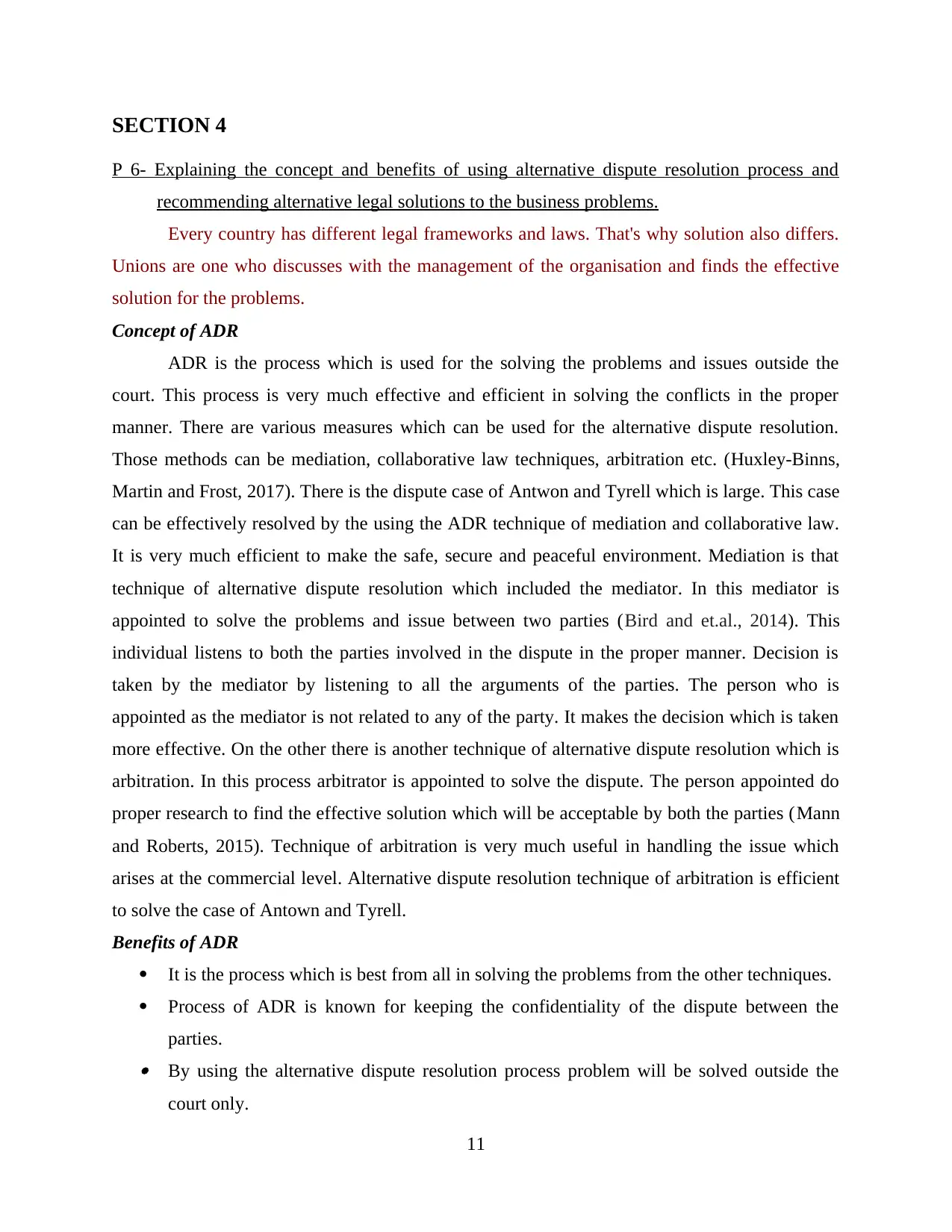
SECTION 4
P 6- Explaining the concept and benefits of using alternative dispute resolution process and
recommending alternative legal solutions to the business problems.
Every country has different legal frameworks and laws. That's why solution also differs.
Unions are one who discusses with the management of the organisation and finds the effective
solution for the problems.
Concept of ADR
ADR is the process which is used for the solving the problems and issues outside the
court. This process is very much effective and efficient in solving the conflicts in the proper
manner. There are various measures which can be used for the alternative dispute resolution.
Those methods can be mediation, collaborative law techniques, arbitration etc. (Huxley-Binns,
Martin and Frost, 2017). There is the dispute case of Antwon and Tyrell which is large. This case
can be effectively resolved by the using the ADR technique of mediation and collaborative law.
It is very much efficient to make the safe, secure and peaceful environment. Mediation is that
technique of alternative dispute resolution which included the mediator. In this mediator is
appointed to solve the problems and issue between two parties (Bird and et.al., 2014). This
individual listens to both the parties involved in the dispute in the proper manner. Decision is
taken by the mediator by listening to all the arguments of the parties. The person who is
appointed as the mediator is not related to any of the party. It makes the decision which is taken
more effective. On the other there is another technique of alternative dispute resolution which is
arbitration. In this process arbitrator is appointed to solve the dispute. The person appointed do
proper research to find the effective solution which will be acceptable by both the parties (Mann
and Roberts, 2015). Technique of arbitration is very much useful in handling the issue which
arises at the commercial level. Alternative dispute resolution technique of arbitration is efficient
to solve the case of Antown and Tyrell.
Benefits of ADR
It is the process which is best from all in solving the problems from the other techniques.
Process of ADR is known for keeping the confidentiality of the dispute between the
parties. By using the alternative dispute resolution process problem will be solved outside the
court only.
11
P 6- Explaining the concept and benefits of using alternative dispute resolution process and
recommending alternative legal solutions to the business problems.
Every country has different legal frameworks and laws. That's why solution also differs.
Unions are one who discusses with the management of the organisation and finds the effective
solution for the problems.
Concept of ADR
ADR is the process which is used for the solving the problems and issues outside the
court. This process is very much effective and efficient in solving the conflicts in the proper
manner. There are various measures which can be used for the alternative dispute resolution.
Those methods can be mediation, collaborative law techniques, arbitration etc. (Huxley-Binns,
Martin and Frost, 2017). There is the dispute case of Antwon and Tyrell which is large. This case
can be effectively resolved by the using the ADR technique of mediation and collaborative law.
It is very much efficient to make the safe, secure and peaceful environment. Mediation is that
technique of alternative dispute resolution which included the mediator. In this mediator is
appointed to solve the problems and issue between two parties (Bird and et.al., 2014). This
individual listens to both the parties involved in the dispute in the proper manner. Decision is
taken by the mediator by listening to all the arguments of the parties. The person who is
appointed as the mediator is not related to any of the party. It makes the decision which is taken
more effective. On the other there is another technique of alternative dispute resolution which is
arbitration. In this process arbitrator is appointed to solve the dispute. The person appointed do
proper research to find the effective solution which will be acceptable by both the parties (Mann
and Roberts, 2015). Technique of arbitration is very much useful in handling the issue which
arises at the commercial level. Alternative dispute resolution technique of arbitration is efficient
to solve the case of Antown and Tyrell.
Benefits of ADR
It is the process which is best from all in solving the problems from the other techniques.
Process of ADR is known for keeping the confidentiality of the dispute between the
parties. By using the alternative dispute resolution process problem will be solved outside the
court only.
11
Paraphrase This Document
Need a fresh take? Get an instant paraphrase of this document with our AI Paraphraser
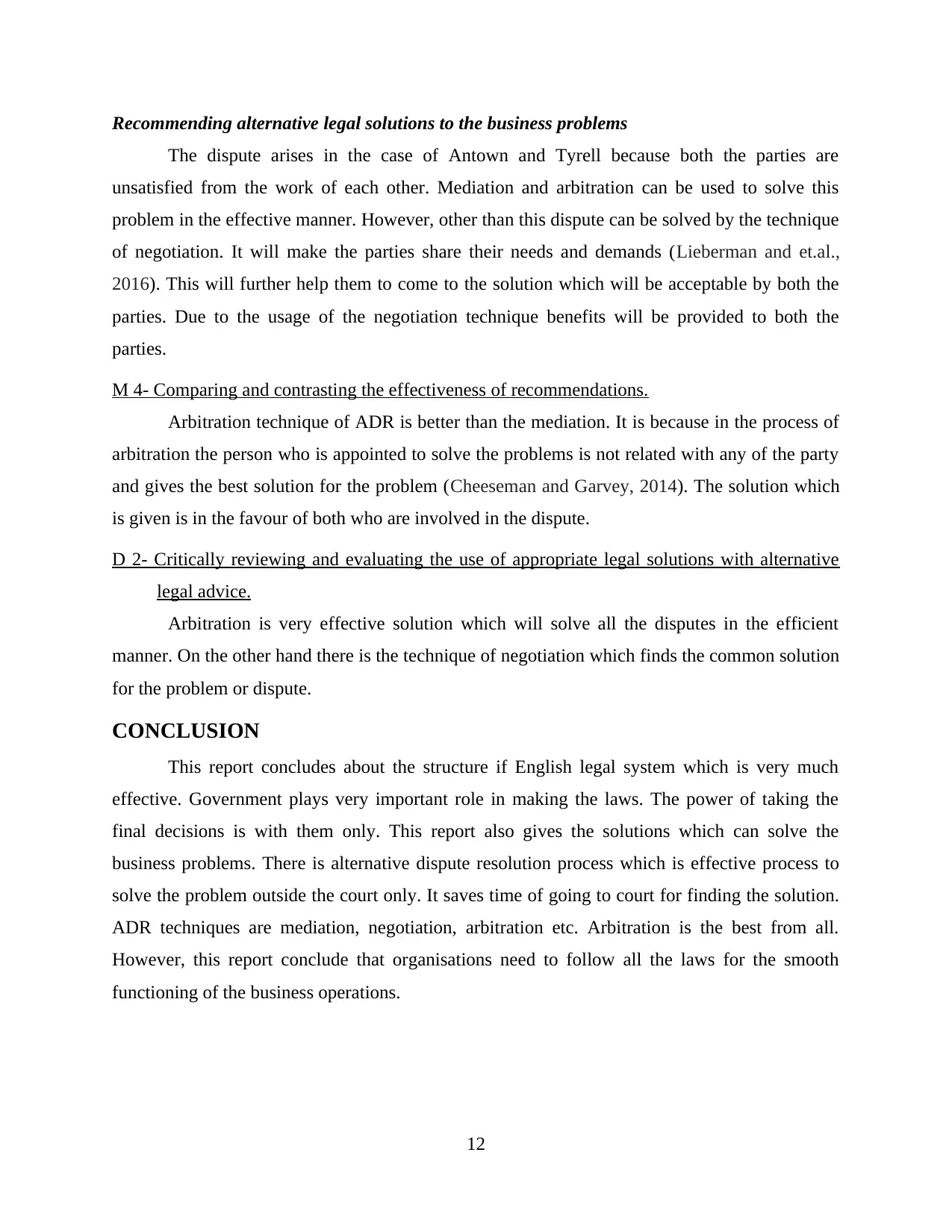
Recommending alternative legal solutions to the business problems
The dispute arises in the case of Antown and Tyrell because both the parties are
unsatisfied from the work of each other. Mediation and arbitration can be used to solve this
problem in the effective manner. However, other than this dispute can be solved by the technique
of negotiation. It will make the parties share their needs and demands (Lieberman and et.al.,
2016). This will further help them to come to the solution which will be acceptable by both the
parties. Due to the usage of the negotiation technique benefits will be provided to both the
parties.
M 4- Comparing and contrasting the effectiveness of recommendations.
Arbitration technique of ADR is better than the mediation. It is because in the process of
arbitration the person who is appointed to solve the problems is not related with any of the party
and gives the best solution for the problem (Cheeseman and Garvey, 2014). The solution which
is given is in the favour of both who are involved in the dispute.
D 2- Critically reviewing and evaluating the use of appropriate legal solutions with alternative
legal advice.
Arbitration is very effective solution which will solve all the disputes in the efficient
manner. On the other hand there is the technique of negotiation which finds the common solution
for the problem or dispute.
CONCLUSION
This report concludes about the structure if English legal system which is very much
effective. Government plays very important role in making the laws. The power of taking the
final decisions is with them only. This report also gives the solutions which can solve the
business problems. There is alternative dispute resolution process which is effective process to
solve the problem outside the court only. It saves time of going to court for finding the solution.
ADR techniques are mediation, negotiation, arbitration etc. Arbitration is the best from all.
However, this report conclude that organisations need to follow all the laws for the smooth
functioning of the business operations.
12
The dispute arises in the case of Antown and Tyrell because both the parties are
unsatisfied from the work of each other. Mediation and arbitration can be used to solve this
problem in the effective manner. However, other than this dispute can be solved by the technique
of negotiation. It will make the parties share their needs and demands (Lieberman and et.al.,
2016). This will further help them to come to the solution which will be acceptable by both the
parties. Due to the usage of the negotiation technique benefits will be provided to both the
parties.
M 4- Comparing and contrasting the effectiveness of recommendations.
Arbitration technique of ADR is better than the mediation. It is because in the process of
arbitration the person who is appointed to solve the problems is not related with any of the party
and gives the best solution for the problem (Cheeseman and Garvey, 2014). The solution which
is given is in the favour of both who are involved in the dispute.
D 2- Critically reviewing and evaluating the use of appropriate legal solutions with alternative
legal advice.
Arbitration is very effective solution which will solve all the disputes in the efficient
manner. On the other hand there is the technique of negotiation which finds the common solution
for the problem or dispute.
CONCLUSION
This report concludes about the structure if English legal system which is very much
effective. Government plays very important role in making the laws. The power of taking the
final decisions is with them only. This report also gives the solutions which can solve the
business problems. There is alternative dispute resolution process which is effective process to
solve the problem outside the court only. It saves time of going to court for finding the solution.
ADR techniques are mediation, negotiation, arbitration etc. Arbitration is the best from all.
However, this report conclude that organisations need to follow all the laws for the smooth
functioning of the business operations.
12
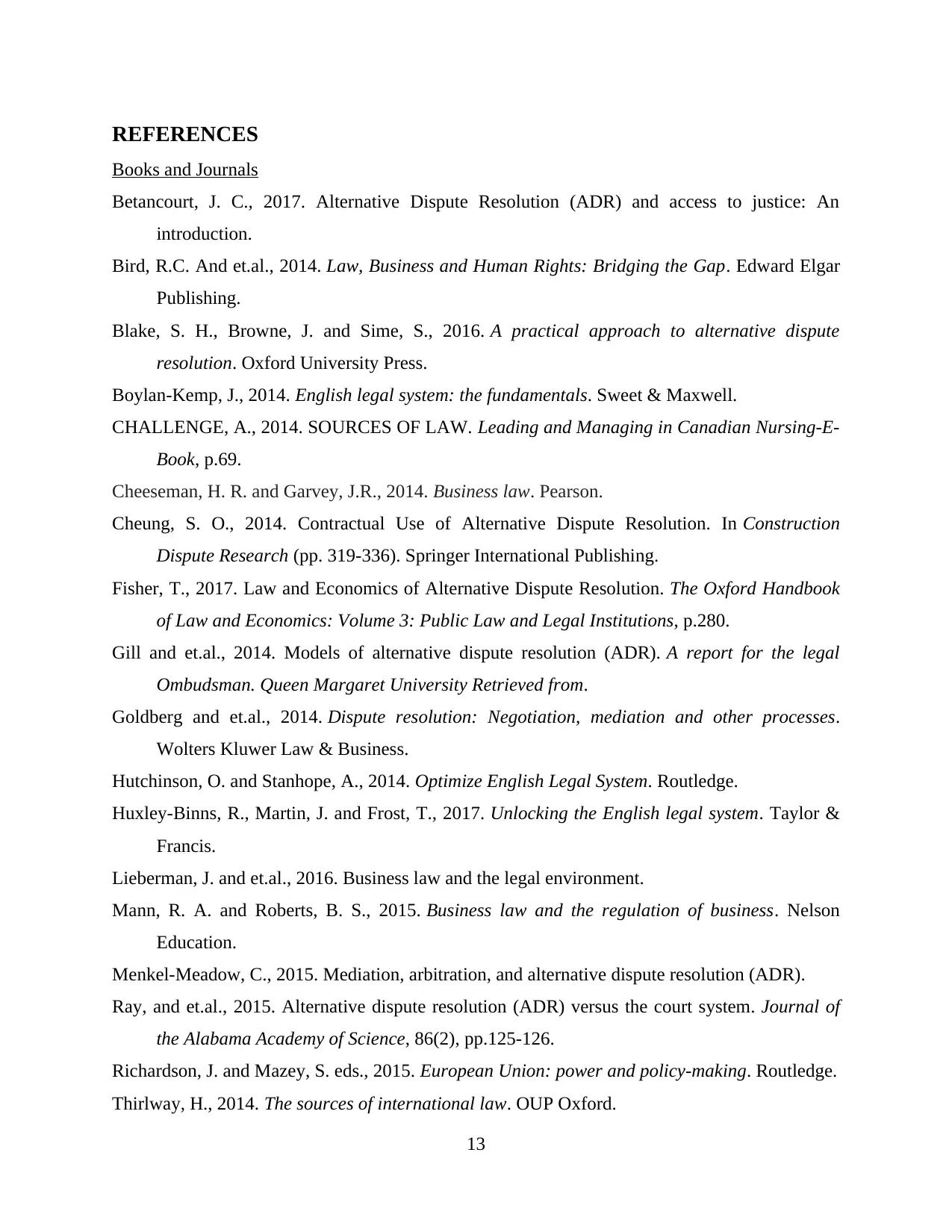
REFERENCES
Books and Journals
Betancourt, J. C., 2017. Alternative Dispute Resolution (ADR) and access to justice: An
introduction.
Bird, R.C. And et.al., 2014. Law, Business and Human Rights: Bridging the Gap. Edward Elgar
Publishing.
Blake, S. H., Browne, J. and Sime, S., 2016. A practical approach to alternative dispute
resolution. Oxford University Press.
Boylan-Kemp, J., 2014. English legal system: the fundamentals. Sweet & Maxwell.
CHALLENGE, A., 2014. SOURCES OF LAW. Leading and Managing in Canadian Nursing-E-
Book, p.69.
Cheeseman, H. R. and Garvey, J.R., 2014. Business law. Pearson.
Cheung, S. O., 2014. Contractual Use of Alternative Dispute Resolution. In Construction
Dispute Research (pp. 319-336). Springer International Publishing.
Fisher, T., 2017. Law and Economics of Alternative Dispute Resolution. The Oxford Handbook
of Law and Economics: Volume 3: Public Law and Legal Institutions, p.280.
Gill and et.al., 2014. Models of alternative dispute resolution (ADR). A report for the legal
Ombudsman. Queen Margaret University Retrieved from.
Goldberg and et.al., 2014. Dispute resolution: Negotiation, mediation and other processes.
Wolters Kluwer Law & Business.
Hutchinson, O. and Stanhope, A., 2014. Optimize English Legal System. Routledge.
Huxley-Binns, R., Martin, J. and Frost, T., 2017. Unlocking the English legal system. Taylor &
Francis.
Lieberman, J. and et.al., 2016. Business law and the legal environment.
Mann, R. A. and Roberts, B. S., 2015. Business law and the regulation of business. Nelson
Education.
Menkel-Meadow, C., 2015. Mediation, arbitration, and alternative dispute resolution (ADR).
Ray, and et.al., 2015. Alternative dispute resolution (ADR) versus the court system. Journal of
the Alabama Academy of Science, 86(2), pp.125-126.
Richardson, J. and Mazey, S. eds., 2015. European Union: power and policy-making. Routledge.
Thirlway, H., 2014. The sources of international law. OUP Oxford.
13
Books and Journals
Betancourt, J. C., 2017. Alternative Dispute Resolution (ADR) and access to justice: An
introduction.
Bird, R.C. And et.al., 2014. Law, Business and Human Rights: Bridging the Gap. Edward Elgar
Publishing.
Blake, S. H., Browne, J. and Sime, S., 2016. A practical approach to alternative dispute
resolution. Oxford University Press.
Boylan-Kemp, J., 2014. English legal system: the fundamentals. Sweet & Maxwell.
CHALLENGE, A., 2014. SOURCES OF LAW. Leading and Managing in Canadian Nursing-E-
Book, p.69.
Cheeseman, H. R. and Garvey, J.R., 2014. Business law. Pearson.
Cheung, S. O., 2014. Contractual Use of Alternative Dispute Resolution. In Construction
Dispute Research (pp. 319-336). Springer International Publishing.
Fisher, T., 2017. Law and Economics of Alternative Dispute Resolution. The Oxford Handbook
of Law and Economics: Volume 3: Public Law and Legal Institutions, p.280.
Gill and et.al., 2014. Models of alternative dispute resolution (ADR). A report for the legal
Ombudsman. Queen Margaret University Retrieved from.
Goldberg and et.al., 2014. Dispute resolution: Negotiation, mediation and other processes.
Wolters Kluwer Law & Business.
Hutchinson, O. and Stanhope, A., 2014. Optimize English Legal System. Routledge.
Huxley-Binns, R., Martin, J. and Frost, T., 2017. Unlocking the English legal system. Taylor &
Francis.
Lieberman, J. and et.al., 2016. Business law and the legal environment.
Mann, R. A. and Roberts, B. S., 2015. Business law and the regulation of business. Nelson
Education.
Menkel-Meadow, C., 2015. Mediation, arbitration, and alternative dispute resolution (ADR).
Ray, and et.al., 2015. Alternative dispute resolution (ADR) versus the court system. Journal of
the Alabama Academy of Science, 86(2), pp.125-126.
Richardson, J. and Mazey, S. eds., 2015. European Union: power and policy-making. Routledge.
Thirlway, H., 2014. The sources of international law. OUP Oxford.
13
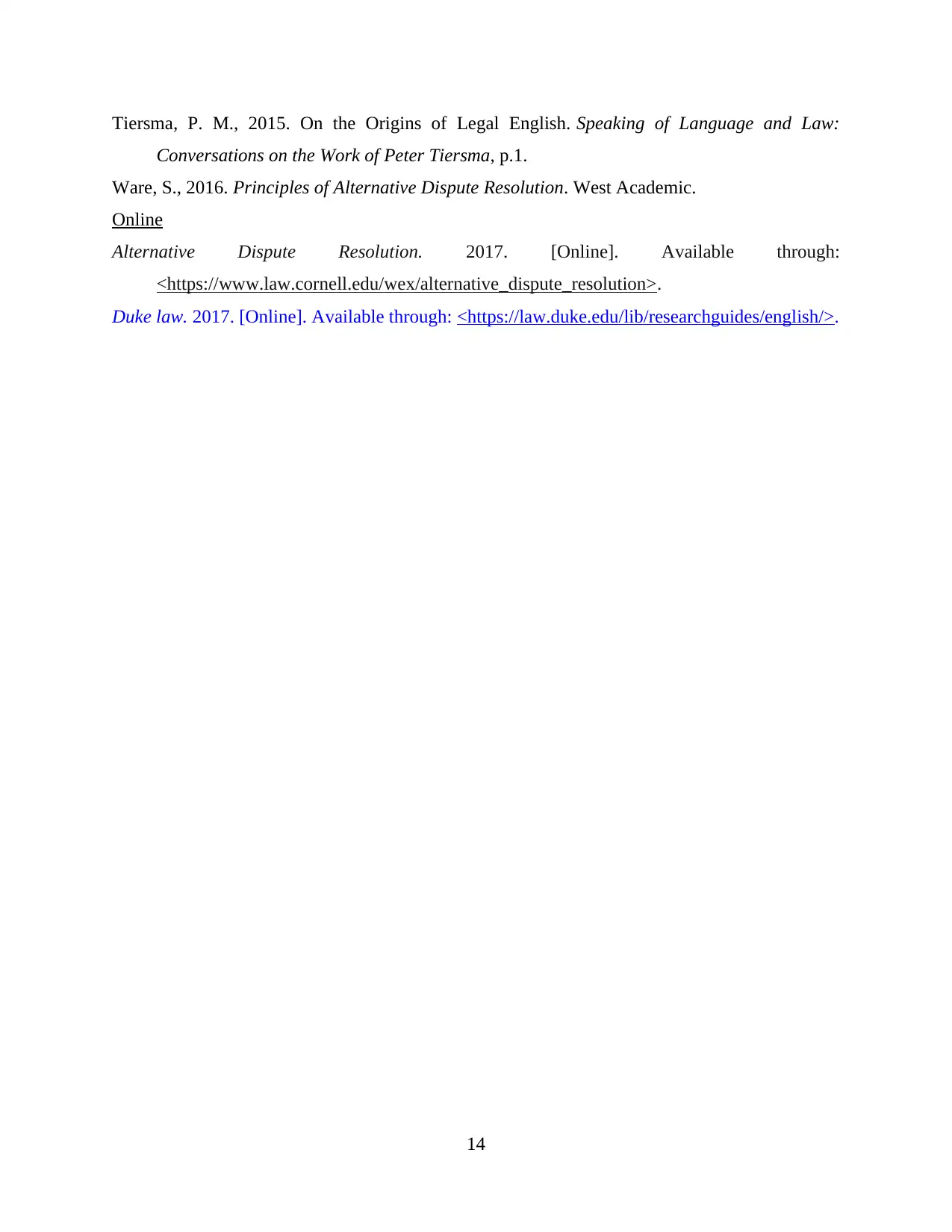
Tiersma, P. M., 2015. On the Origins of Legal English. Speaking of Language and Law:
Conversations on the Work of Peter Tiersma, p.1.
Ware, S., 2016. Principles of Alternative Dispute Resolution. West Academic.
Online
Alternative Dispute Resolution. 2017. [Online]. Available through:
<https://www.law.cornell.edu/wex/alternative_dispute_resolution>.
Duke law. 2017. [Online]. Available through: <https://law.duke.edu/lib/researchguides/english/>.
14
Conversations on the Work of Peter Tiersma, p.1.
Ware, S., 2016. Principles of Alternative Dispute Resolution. West Academic.
Online
Alternative Dispute Resolution. 2017. [Online]. Available through:
<https://www.law.cornell.edu/wex/alternative_dispute_resolution>.
Duke law. 2017. [Online]. Available through: <https://law.duke.edu/lib/researchguides/english/>.
14
Secure Best Marks with AI Grader
Need help grading? Try our AI Grader for instant feedback on your assignments.

15
1 out of 17
Related Documents
Your All-in-One AI-Powered Toolkit for Academic Success.
+13062052269
info@desklib.com
Available 24*7 on WhatsApp / Email
![[object Object]](/_next/static/media/star-bottom.7253800d.svg)
Unlock your academic potential
© 2024 | Zucol Services PVT LTD | All rights reserved.





